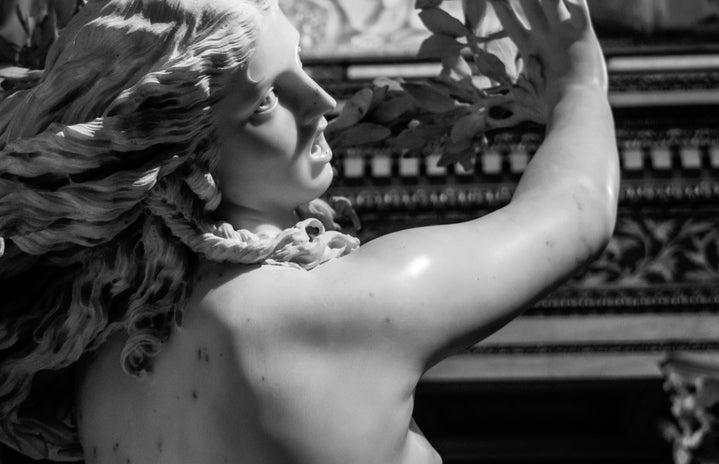Nothing beats female rage in the competition for compelling storylines. A girl slighted by the system embraces the power she holds, instilling fear in the people who ever tried to hold her down. It’s a subset of horror in the way it allows us to experience something exhilarating, that we’ve continuously thought about doing, but never experienced first-hand usually for fear of retribution. When I first read Circe as a young tween, I found myself inexplicably attached to Circe’s sister, Pasiphae. If you, like I, had never heard of her you probably at least know of her son, the Minotaur. Like a lot of women in Greek mythology, she gains notoriety from the men around her, and only a select few stand out on their own. Off the top of my head, I can think of Helen and Medea, and neither of them carries the best reputation. Being a woman in Greek mythology means you are either the victim or the villain, a crossroads that both lead to the same end. The illusion of choice, if you are a woman on stage, you must suffer. Pasiphae is not spared this distinction; she is a villain for producing the Minotaur. And yet, within all the stories of villainous women, there is an inkling of independence and violent freedom.
Pasiphae’s story gives insight into a little looked at subsection of the female rage storyline, which I have named the “Monster Mother.” The word “monster” refers to the creation and “mother” refers to the creator. The created-creator relationship only counts as a subset of feminine rage when it exists in a vengeful feminine context. The monster mother is a character who recognizes the injustice of their place in society and who uses their innate power to intimidate those around them and essentially say, “Look what I just did, imagine what else I am capable of.”
Pasiphae’s story starts with her parents, Helios the sun god, and Perseis the water nymph. Based on what’s known of Greek customs, she was likely married off before the age of 15. Her husband was King Minos who was unlikely to have been less than 30 when they were married. In Greek culture, men could have affairs, but women couldn’t, and so from the age of 15, she knew she would never be given the ability to openly experience true love, a heart-wrenching thought for any 15-year-old. Pasiphae had 7 kids from her marriage to Minos. Being royalty, she would have been placed under many restrictions. She was likely confined to a women’s quarter where she was expected to weave and sew, or other “women’s” pastimes. She was a woman in an ivory cage.
This is where the story gets exciting, Pasiphae gets impregnated by a bull. The story goes that, as punishment for Minos’s inability to fulfil his end of a bargain, Pasiphae was cursed with lust for the bull. Here’s the thing, gods were often using mortals to insult those who slighted them, divine or not, which makes this seem a natural course of action for revenge against Minos. The difference is, Pasiphae was not a mortal, her dad being a god and her mom being a nymph caused her to possess powers of witchcraft and gave her status as a celestial goddess. She was not just a pawn to be played with like other mortal women.
My personal theory is that she was on the brink of a breakdown. She was starved for love, space, and a break. She needed to gain control of her life, and as the controller of her, Minos was the target, she needed to do something that would both scare him and humiliate him forever thinking she could be caged. As men were allowed to cheat and women weren’t, her cheating would be a great insult. Of course, this would also be an insult to her dad, brothers, and any other man pulling the strings of her life. So, she teamed up with the incredible craftsman Daedalus to create a bull disguise, and trick the bull into fornicating with her. I also believe, with her being a witch, she used a bit of her own magic to help with the conception. She gave birth to the Minotaur, shame to her husband, shame to her father, and shame to the city of Crete. The cherry on top is that she named it the Minotaur. Now whenever Minos sees it, hears it, or thinks of it, he is reminded that it is partly his own making.
The theory of the monster mother is based on this principle. A person placed into a system in which they feel confined uses their ascribed role and innate power to intimidate and cause havoc on their confiners. Like all the other tragedies this trope has been reused, renewed, and recycled in hundreds of ways, including in some of our favourite movies.
1. Matilda
Matilda, written by Roald Dahl and directed by Danny DeVito, is an example of a children’s book and movie whose story is based on the monster mother plot. Matilda is given a role by her family and school, as the disobedient, “weird” child. After being bullied for long enough by her dad and principal, she was at her wit’s end, and she needed to teach them a lesson. She uses her newfound power of mischief and telekinesis to play pranks and serve justice to the people around her.
“[I thought grown-ups weren’t afraid of anything.] Quite the contrary. All grown-ups get scared, just like children.” – (Ms. Honey, Matilda)
2. Everything Everywhere All at Once
In Everything Everywhere All at Once, directed by Daniel Kwan and Daniel Scheinert, Evelyn and her daughter Joy have a precarious relationship that creates a cataclysmic disaster. Evelyn feels stifled by her life as a laundromat owner and Joy feels stifled by Evelyn. In an alternate universe, Evelyn pushes Joy to “verse jump” past her endurance subsequently splintering her mind. This causes a rift in their relationship and Joy is out for revenge. A good question to ask: how much joy is just a reflection of Evelyn’s anger and frustration at her place in the world? Which one is playing the role of the monster, and which is the mother? I think that in this story they both are.
“It’s okay if you can’t be proud of me. Because I finally am.” – (Evelyn Wang, Everything Everywhere All at Once)
3. Jennifer’s Body
Jennifer’s Body, directed by Karen Kusama, follows a teenage girl named Jennifer who decides to follow a boy band into their van after a fire burns down the bar they were playing at. Jennifer becomes subject to a supernatural sacrifice and is transformed. She is gifted with a power that she uses to destroy the boys at her school and instil fear in the town. She knew from the beginning of the power she had, being an attractive girl in a small town. She was overlooked as a murderer, and dismissed as the classic mean girl, she lived in the stereotype and used it to cause havoc undetected.
“I need you frightened. I need you hopeless.”
– (Jennifer, Jennifer’s Body)
From children’s fiction to sci-fi, to horror, this trope persists, and these are just three of many examples. The plot of the monster mother isn’t secret or hidden; its clear use in the media litters our screens and yet it went unidentified for a long time. The realm of anger in film has not been explored enough, we only have one umbrella term, “feminine rage.” But within that is a grotto of different types of rage manifestations. There’s also non-feminine rage yet to be explored, the social systems that bind gender non-conforming people are different than the systems that confine women. It is left to the viewers, the fans, and the fanatic watchers, to make these identifications and tell their stories. It’s up to us to interpret our own experiences and turn them into something frightening.


